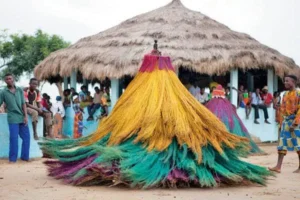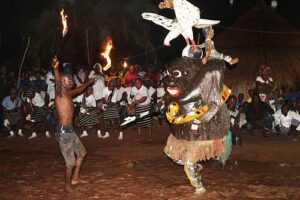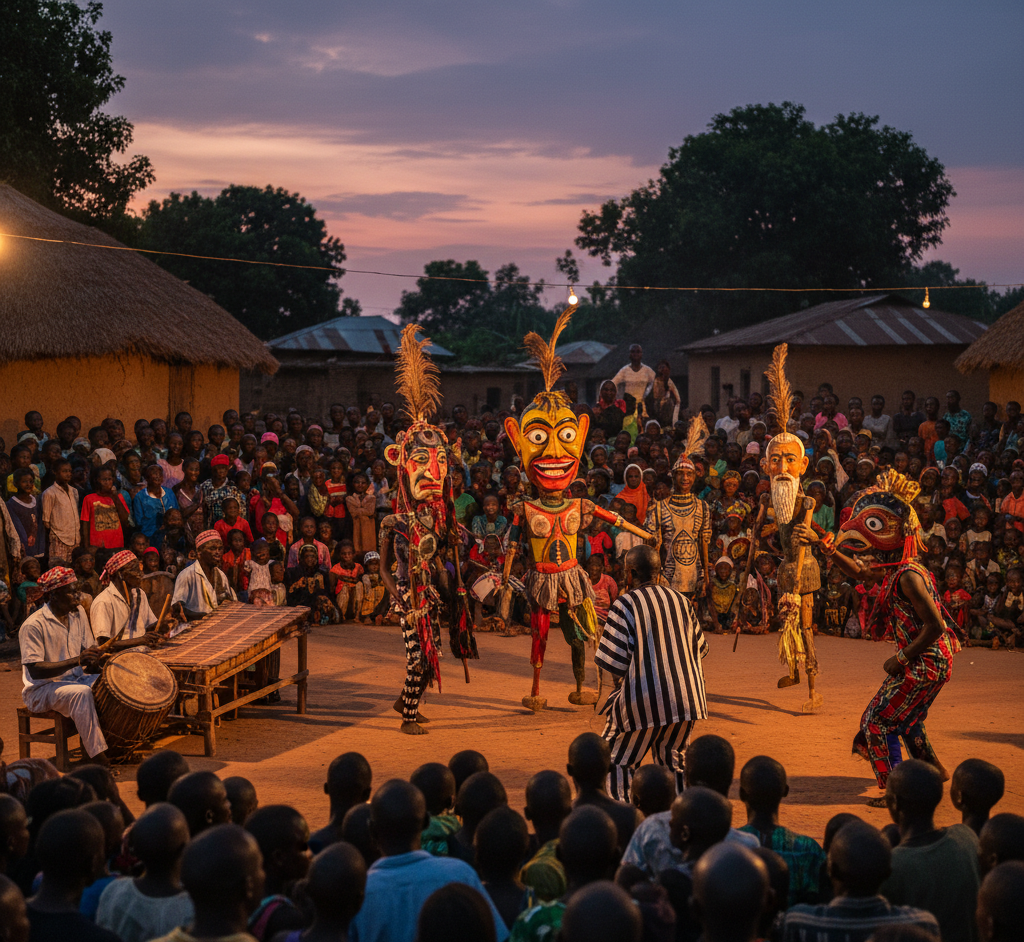The Kwagh-Hir is a magnificent and multifaceted traditional theatre art form originating from the Tiv people of Benue State, Nigeria. More than just entertainment, Kwagh-Hir is a vibrant cultural institution that combines puppetry, masquerade, music, dance, and storytelling into a dynamic spectacle that both entertains and educates. Recognized by UNESCO as a Masterpiece of the Oral and Intangible Heritage of Humanity, it stands as a testament to the Tiv’s rich artistic ingenuity and their profound connection to community.
What is Kwagh-Hir?
The term “Kwagh-Hir” literally translates from the Tiv language to “something magical” or “a wondrous thing.” It encapsulates the awe and wonder that the performance evokes. Unlike many other African masquerade traditions that focus on ancestral spirits or deities, Kwagh-Hir is primarily a secular theatre that vividly reflects and critiques contemporary Tiv society.
- Holistic Performance: A Kwagh-Hir performance is not a singular act but a grand composite of various artistic elements, presented by a troupe (ityough ki kwagh-hir) that can number dozens of performers, musicians, and puppeteers.
- Communal Participation: It is a deeply communal art form, with performances often taking place in open spaces, drawing large audiences who are actively engaged—laughing, cheering, and sometimes even interjecting.
Origins and Evolution
The exact origins of Kwagh-Hir are steeped in local folklore, but it is believed to have developed in the mid-20th century (around the 1960s). It emerged as a creative response to, and reflection of, societal changes, colonial influences, and a desire to preserve and project Tiv identity. Initially, performances might have been more localized, evolving over time into the sophisticated, highly mobile troupes seen today.
The Elements of a Kwagh-Hir Performance

A typical Kwagh-Hir show is a medley of acts, each designed to convey a specific message or simply to delight.
- Puppetry: This is the most iconic feature. Intricately carved wooden puppets, often controlled by puppeteers hidden beneath a cloth screen or operating from within large costumes, are used to depict a wide array of characters—humans, animals, mythical creatures, and even inanimate objects. These puppets are known for their expressive movements and often grotesque or humorous designs.
- Masquerade: Performers adorned in elaborate costumes and masks represent various figures, sometimes embodying spirits or, more commonly, caricatures of social types (e.g., corrupt officials, arrogant youths, wise elders).
- Music and Dance: Live musical ensembles featuring drums (ganga), flutes (adiguve), and xylophones (garagbo) provide the rhythm and atmosphere. Dancers often perform energetic, acrobatic routines that punctuate the narrative.
- Storytelling (Kwagh-A-Kondo): The narrative aspect, often humorous or satirical, draws on Tiv folktales (kwagh-alom), historical events, and current affairs. The stories are designed to teach moral lessons, highlight societal ills, or simply entertain with their wit and drama.
- Magic and Illusion: True to its name, elements of illusion and “stage magic” are often incorporated, adding to the spectacle and reinforcing the “wondrous” aspect of Kwagh-Hir.

Social Commentary and Function
Kwagh-Hir is not merely entertainment; it serves profound social and cultural functions within the Tiv community:
- Moral Education: Through satirical skits and allegorical tales, it critiques corruption, celebrates virtue, and reinforces communal values like honesty, hard work, and respect for elders.
- Historical Preservation: It acts as a living archive, recounting historical events and preserving collective memory.
- Cultural Affirmation: It is a powerful affirmation of Tiv identity, language, and artistic expression, especially important in an increasingly globalized world.
- Community Cohesion: The performances foster a sense of shared experience and community spirit, bringing people together from all walks of life.
Global Recognition and Modern Challenges
The global significance of Kwagh-Hir was acknowledged in 2005 when UNESCO proclaimed it a Masterpiece of the Oral and Intangible Heritage of Humanity. This recognition highlights its artistic value and the urgent need for its preservation.
Despite this honor, Kwagh-Hir faces modern challenges, including:
- Succession and Funding: Attracting younger generations to learn and master the complex art form, and securing funding for troupes in a changing economic landscape.
- Modern Entertainment: Competition from modern media and entertainment.
Nevertheless, the Kwagh-Hir endures, a testament to the Tiv people’s creative spirit and their commitment to keeping their “wondrous thing” alive, continuing to tell their stories with magic and vibrancy.


Leave a Reply